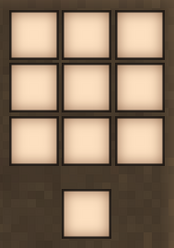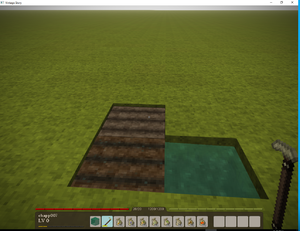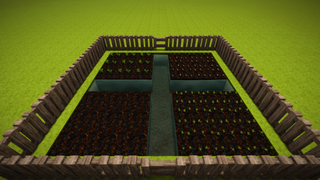Farming/zh: Difference between revisions
(Created page with "==== 轮作 ====") |
(Created page with "作物轮作是指随着时间推移在同一耕地种植不同作物的做法,自古以来就被用来最大限度地提高作物产量。依赖氮(N),磷(P),钾(K)的作物可以在同一片农田中轮作。例如,在收获胡萝卜等依赖氮(N)的作物后,农田中的氮(N)含量较低,但其他两种养分的含量较高。因此,依赖磷(P)或钾(K)的作物可以随后种植在这片田中。") |
||
| Line 112: | Line 112: | ||
</div> | </div> | ||
作物轮作是指随着时间推移在同一耕地种植不同作物的做法,自古以来就被用来最大限度地提高作物产量。依赖氮(N),磷(P),钾(K)的作物可以在同一片农田中轮作。例如,在收获胡萝卜等依赖氮(N)的作物后,农田中的氮(N)含量较低,但其他两种养分的含量较高。因此,依赖磷(P)或钾(K)的作物可以随后种植在这片田中。 | |||
<div lang="en" dir="ltr" class="mw-content-ltr"> | <div lang="en" dir="ltr" class="mw-content-ltr"> | ||
Revision as of 04:36, 30 May 2024
This page was last verified for Vintage Story version 1.16.4.
農業 是一種遊戲機制,允許玩家種植糧食作物用於 烹飪 和餵養 飢餓的動物。
所需道具
在開始種植前, 玩家需要好的 土壤 和用於種植的種子。 還需要使用 鋤頭 來將土壤轉變為農田。 玩家還需要通過水體, 或使用 澆水壺 來為生長的植物提供水分。
尋找種子
野生作物 在世界生成時被創造,可以在世界各地不同的氣候區域中找到。破壞這些植物是收集種子的關鍵。未成熟的野生作物在被破壞時不一定會掉落種子。野生作物會生長,即便區塊還未被加載,它們的生長也不會受溫度影響。但是,如果野生作物在完全生長後沒有被收穫,它們將繼續生長並變回第一階段。
種子同樣能在位於 廢墟 的種子和農業 破裂黏土罐 中找到 - 一些種子 只能 通過這種方式獲取。
| 種子類型 | 產物 | 氣候 |
|---|---|---|
| 胡蘿蔔 | 溫帶 | |
| 亞麻 | 溫帶 | |
| 洋蔥 | 溫帶 | |
| 斯佩爾特小麥 | 溫帶 | |
| 大頭菜 | 溫帶 | |
| 歐防風 | 溫帶 | |
| 黑麥 | 溫帶 | |
| 稻米 | 熱帶 | |
| 大豆 | 熱帶 | |
| 莧米 | 熱帶 | |
| 甜椒* | 熱帶 | |
| 木薯 | 熱帶 | |
| 花生 | 熱帶 | |
| 菠蘿 | 熱帶 | |
| 葵花 | 熱帶 | |
| 南瓜 | 只能從廢墟獲得 | |
| 捲心菜 | 只能從廢墟獲得 |
*在1.16.4版本之前,甜椒會生成野生作物並掉落種子,但不會產出果實。
土壤和農田
自然生成的土壤
在世界中有四種擁有不同肥力的天然 土壤 : 貧瘠 5%, 低 25%, 中 50%, 和 高 65%。 當土壤被破壞並放置在其他地方時,該土壤的肥力不會改變,因此最好的辦法是尋找高肥力的土壤並將其帶回家用於耕種。
玩家製作的土壤
黑土 是一種由玩家製作的土壤,擁有80%的肥力。每塊黑土的製作需要: 將64 腐爛物 密封在 木桶 中20天, 然後使用產生的堆肥在合成欄中與4個骨粉和4個木炭組合。
| Ingredients | Crafting Recipe |
|---|---|
| 8x 堆肥 4x 骨灰 4x 木炭 |
創造農田
在土壤方塊上
使用 鋤頭 + ![]() 來創造乾燥的田地。如果農田附近三格範圍內有淡水方塊,它將從乾燥轉變為濕潤。 也可以通過雨水或者使用澆水壺來將農田濕潤。 高於50%的含水量可以提高作物的盛裝速度,具體來講,如果含水量保持在100%,則可減少作物每個階段最多兩小時遊戲時間的生長時間。
來創造乾燥的田地。如果農田附近三格範圍內有淡水方塊,它將從乾燥轉變為濕潤。 也可以通過雨水或者使用澆水壺來將農田濕潤。 高於50%的含水量可以提高作物的盛裝速度,具體來講,如果含水量保持在100%,則可減少作物每個階段最多兩小時遊戲時間的生長時間。
水體能為其三格範圍內的水平相鄰農田提供水分,包括對角線上的。農田每遠離水體一格,其獲得的含水量加成便會降低25%。也就是說,緊挨着水方塊的農田將獲得75%的含水量,兩格外的農田將獲得50%的含水量,三格外的農田將獲得25%的含水量。農田無法從垂直方向上的水體中吸收水分(也就是說直接搭建在水面上方的農田無法從其下方的水中獲得水分)。
鹽水無法用於提供水分,它會立刻殺死作物。
農田方塊一但放下便無法被拾起或替換 。 破壞農田方塊不會產生掉落物。
土壤養分
所有的土壤,泥土,無論潮濕還是乾燥,擁有三種養分:N,P和K。每種作物都會消耗其中一種養分。一些作物要比其他作物消耗的更多,如下表所示。不同作物的生長速度也不同,這由生長天數表示。
作物從一個生長階段進入下一個生長階段的過程中,它們會消耗農田中的養分,降低農田的養分含量。所需養分K,P或N是該作物消耗的養分。每個生長階段所需的養分量可通過總消耗養分量除以該作物的生長階段數量來計算。
養分補充
農田中的養分會隨着時間緩慢補充至該土壤種類的最大養分水平,例如中等肥力的土壤會緩慢補充至50%的養分。如果有作物在其上生長,養分補充速度較慢,沒有種植作物時則更快。當前作物消耗的養分的補充速度將比其他兩種未使用的養分的補充速度更慢,並且實際上並不會進行增長,因為作物會隨着生長不斷消耗該養分。如果農田上的作物成熟,任何養分都不會再自動補充。
遊戲內每3到4小時補充一次養分。
輪作
作物輪作是指隨着時間推移在同一耕地種植不同作物的做法,自古以來就被用來最大限度地提高作物產量。依賴氮(N),磷(P),鉀(K)的作物可以在同一片農田中輪作。例如,在收穫胡蘿蔔等依賴氮(N)的作物後,農田中的氮(N)含量較低,但其他兩種養分的含量較高。因此,依賴磷(P)或鉀(K)的作物可以隨後種植在這片田中。
A common crop rotation strategy is to divide the fertile area into four sections, one each for N, P, or K-dependent crops and one left fallow (without any crops growing). In the screenshot on the right, turnips (N-dependent) are planted in the top left, onions (P-dependent) in the top right, carrots (K-dependent) in the bottom right and the bottom left area are left without any crops. After harvest the planting will be rotated clockwise so that turnips will now be planted in the top right, onions in the bottom right, carrots in the bottom left and the top left will not have any crops. Rotate clockwise again after each harvest.
Note that the rotation will depend on the slowest crop to mature which in this case are the carrots (4 in-game days). Because nutrients replenish best in fallow soil, one area is kept unplanted during each rotation. This strategy is particularly useful if the player does not have access to fertilizer yet. You can make variations on this strategy to suit your crop mix.
Fertilizer
Fertilizers such as saltpeter, potash and bonemeal can be applied to the soil to replenish nutrients depleted by the growth of crops without waiting for the slow natural replenishment in fallow soil (no crops planted) or the need for crop rotation.
For example, the important crop flax removes potassium from the soil as it grows. Adding potash or saltpeter to the depleted soil after harvest will replenish potassium levels and allow replanting of flax on the same soil without waiting for natural replenishment and without the need for crop rotation. The type and amount of nutrient required for each crop is shown in the table of available crops in the next section. Having sufficient nutrients for each crop allows for the optimal growth rate if temperature and light requirements are also met.
Using fertilizer is the only time a soil type can exceed the maximum nutrient level of the soil type.
Note that saltpeter cannot be detected by a prospecting pick and must be found while exploring caves.
| Fertilizer | Nitrogen (N) % | Phosphorus (P) % | Potassium (K) % | Obtention |
|---|---|---|---|---|
| 0 | 0 | 60 | grinding sylvite | |
| 13 | 0 | 44 | mined from caves | |
| 3 | 30 | 0 | grinding bones | |
| 40 | 8 | 8 | sealing 64 rot in a barrel for 20 days |
Crops
To harvest, left-click on the crop with an empty hand or harvesting tool, knife or scythe. Fully mature crops will return seeds, food, and in the case of flax, fiber. All fully mature crops have about a 5% chance of dropping an extra seed when harvested. Each crop is characterized by a set of Crop Properties. Crop properties consist of the following individual properties:
- Growth Stages - The number of growth stages for a crop.
- Total Growth Days - The number of in-game days it takes for a crop to be fully grown (harvestable).
- Nutrient - The type of nutrient (N, P, K) consumed from the farmland when a crop grows to the next stage.
- Nutrient Consumption - The total amount of the required nutrient that will be consumed over the lifetime of a crop.
- Cold/ Heat Resistance - Temperature range the crop can endure before it takes damage and then will yield less harvest on breaking. Generally, all crops can keep growing only above 0°C. They might be able to endure lower temperatures without damage, but will not be able to grow under such circumstances. The only way to artificially regulate temperature for crop growth at the moment is through the use of a greenhouse structure, which will raise the temperature by 5°C. Keep in mind that getting too cold or too hot can halve the harvest of a crop or even kill a crop entirely, but the seeds will always be dropped.
- Yield - The amount of edible produce items that are dropped when a fully-grown crop is harvested.
Table of available crops
| Crop | Growth Stages |
Total Growth | Nutrient | Nutrient Consumption |
Temperature Resistance | Yield | ||
|---|---|---|---|---|---|---|---|---|
| Months | Days* | Cold | Heat | |||||
| 7 | 1.20 | 10.80 | K (Potassium) | 40 | -10°C | 32°C | 9 - 13* | |
| 9 | 2.00 | 18.00 | K (Potassium) | 50 | -5°C | 40°C | 7 - 9* | |
| 7 | 1.85 | 16.65 | P (Phosphorus) | 35 | -1°C | 40°C | 10 - 14* | |
| 9 | 2.00 | 18.00 | N (Nitrogen) | 40 | -5°C | 40°C | 10 - 14* | |
| 5 | 1.00 | 9.00 | N (Nitrogen) | 30 | -5°C | 27°C | 6 - 8* | |
| 8 | 2.00 | 18.00 | P (Phosphorus) | 20 | -10°C | 32°C | 10 - 14* | |
| 10 | 2.25 | 20.25 | K (Potassium) | 50 | 8°C | 46°C | 11 - 15* | |
| 9 | 2.00 | 18.00 | N (Nitrogen) | 40 | -12°C | 27°C | 9 - 13* | |
| 11 | 1.25 | 11.25 | K (Potassium) | 35 | -5°C | 40°C | 5 - 7* | |
| 9 | 2.00 | 18.00 | N (Nitrogen) | 15 | 6°C | 42°C | 5 - 7* | |
| 19 | 2.20 | 19.80 | N (Nitrogen) | 35 | 8°C | 34°C | Not implemented | |
| 9 | 5.00 | 45.00 | K (Potassium) | 25 | 4°C | 44°C | 14 - 18* | |
| 9 | 2.50 | 22.50 | P (Phosphorus) | 45 | 10°C | 42°C | 8 - 12* | |
| 16 | 6.00 | 54.00 | N (Nitrogen) | 15 | 6°C | 48°C | 1 | |
| 12 | 1.85 | 16.65 | N (Nitrogen) | 40 | -5°C | 40°C | 11 - 15* | |
| 8 | 1.70 | 15.30 | P (Phosphorus) | 30 | -5°C | 40°C | Variable** | |
| 12 | 1.50 | 13.50 | N (Nitrogen) | 40 | -5°C | 35°C | 2 | |
*Growth times are calculated based on number of days in a month. Changing the length of a month will change the total growth time in days proportionally.
**Pumpkins are cultivated differently than all other crops. Please see the pumpkin page for detailed instructions about establishing a pumpkin patch.
Fruit trees
Fruit trees were introduced in the Homesteading Update (v.1.16). There are a total of nine different types of fruit-bearing trees: red apple, pink apple, yellow apple, peach, pear, cherry, orange, olive, and mango. Some of the trees, like mango and orange, are specifically adapted to warmer climates, whereas apples, pears, and peaches thrive in temperate climates.
After a fruit tree is found in the wild, a tree cutting can be acquired by breaking its branches with an axe. Each cutting has a 40% chance to grow into a full tree when planted in the ground - if the temperature requirements are met. Some trees must go through "vernalization," when the temperature drops down below a certain point, for them to set fruit.
Protecting crops
Hares will go after planted crops and eat them. They will leave behind a dead plant that drops one seed, but no crops. Some crops are not eaten by hares, namely onions, pineapples, and pumpkins. These can be planted without protection if grown alone.
Since rabbits spawn on grass blocks, rabbit-proofing farms with walls, fences, or a two-block deep dry moat around farm blocks is recommended. Players must take care to leave no grass blocks within the enclosed area. The moat has the bonus of catching hungry rabbits when they try to reach the player's crops. Keep in mind that adult rabbits can jump over a single fence block if it is bordered by water. Rabbit spawns can also be blocked inside an enclosed area by placing stones on the ground or removing all grass. Grass that grows on fallow farm blocks does not grow tall enough to be a valid rabbit spawn.
Rabbits ignore wild crops.
Underground farming
Version 1.14 introduced significant limitations on underground farming. There is a soft limit for plant growth concerning depth below sea level. Each level below sea level requires one extra light level for the crop to grow, and below light level 19, each farther level incurs a 10% growth penalty, which means growth will stop entirely at or below light level 9.
Given that the sun's light level is 22, this means that with direct sunlight shafts alone, farms can be placed at a maximum of 3 levels below sea level without incurring growth penalties, and a maximum of 12 levels below sea level before growth stops completely.
With a fully set chandelier (providing light level 24), a slightly lower depth might be reached. However, light levels do not accumulate, meaning combining a light shaft with light level 22 and a lantern with light level 18 will still result in a maximum light level of 22.
"Underground" farms in a mountain range above sea level would however still be possible, as long as the required light level for growth is achieved with sun or artificial light.
In a default height world, the sea level is 110.
Food and cooking
The efficiency values below in the "Satiety/Growth time (days)" column are based on the average yield of a crop from one tile of farmland, multiplied by the food's satiety, divided by the number of growth days until maturity. Note that pumpkins, while they only require a single block of farmland, are spread out to cover a wider area of dirt. This space efficiency was not taken into account.
| Seed Type | Category | Satiety | Satiety/Growth time (days) | ||||
|---|---|---|---|---|---|---|---|
| Raw | 烹飪 | 烹飪 | Raw | 烹飪 | 烹飪 | ||
| Vegetable | 100 | 150 | N/A | 75.00 | 112.50 | N/A | |
| Grain | 30 | 120 | 160 | 10.58 | 42.35 | 53.33 | |
| Vegetable | 100 | 150 | N/A | 75.00 | 112.50 | N/A | |
| Grain | 60 | 240 | 300 | 40.00 | 160.00 | 200.00 | |
| Vegetable | 100 | 150 | N/A | 100.00 | 150.00 | N/A | |
| Vegetable | 100 | 150 | N/A | 50.00 | 75.00 | N/A | |
| Grain | 60 | 280 | 330 | 40.00 | 186.67 | 211.85 | |
| Grain | 60 | 240 | 300 | 36.00 | 144.00 | 183.33 | |
| Protein | 150* | 240 | N/A | 81.82 | 130.91 | N/A | |
| Grain | 60 | 240 | 300 | 20.00 | 80.00 | 100.00 | |
| Vegetable | 100 | 120 | N/A | 35.71 | 42.86 | N/A | |
| Grain | N/A | N/A | 300 | N/A | N/A | 106.67 | |
| Protein | 160 | N/A | N/A | 73.85 | N/A | N/A | |
| Fruit | 320* | 480* | N/A | 6.67 | 10.00 | N/A | |
| Grain | 60 | 240 | 300 | 48.00 | 192.00 | 234.23 | |
| Vegetable | 480* | 720* | N/A | 102.86 | 154.28 | N/A | |
| Vegetable | 300 | 450 | N/A | 46.15 | 69.23 | N/A | |
- Soybeans cannot be eaten raw, but they can be pickled and then eaten in this state.
- Cassava cannot be eaten raw off the vine. It must first be soaked in a sealed barrel and skinned with a knife, but it can then be eaten in this state.
- Pineapples and pumpkins cannot be eaten nor cooked whole. They must first be sliced with a knife, producing 4 pieces each with exactly 25% of the entire produce's satiety.
- Pumpkins' growth varies wildly, but community experimentation appears to have resulted in approximately 1.5 pumpkins' profit per vine, on average (assuming 2.5 are grown and 1 is used to produce the next pumpkin seed). The numbers above reflect this.
History
- In version 1.19.0-rc.1, High Fertility Soil was changed to occur naturally in the world, and Terra Preta can only be crafted.[1] The recipe for Terra Preta in 1.19 is more expensive than the recipe for High Fertility Soil was in 1.18.
Notes
- It is recommended to harvest all wild crops, regardless of growth stage, when out on a long journey, if the player foresees that they will not come the same way again.
Gallery
See also
Video Tutorials
| Detailed explanation including changes since version 1.13 | Detailed explanation of pumpkin plants |
|---|---|
References
- ↑ "Tweak: Terra Preta is no longer generated during worldgen. High fertility soil will be generated instead. Terra Preta is now made in the crafting grid, as high fertility soil was previously. However crafting Terra Preta requires charcoal and bone meal, in addition to compost. High fertility soil can be included in the recipe, to increase the yield of Terra Preta." Official Devlog
| Farming | |
|---|---|
| Wild foods | Berries • Cactus (saguaro) fruit • Mushrooms • Cattail (and papyrus) |
| Grains | Amaranth • Cassava • Flax • Rice • Rye • Spelt • Sunflower |
| Vegetables | Cabbage • Carrot • Onion • Turnip • Parsnip • Peanut • Pumpkin • Soybean |
| Fruits | Fruit trees • Pineapple |
| Other | Fertilizer • Beekeeping • Room |
| Tools | Hoe • Scythe • Fruit press |
| See also | Animal husbandry • Cooking • Food preservation |
| Wiki Navigation | |
|---|---|
| Vintage Story | Guides • Frequently Asked Questions • Soundtrack • Versions • Controls |
| Game systems | Crafting • Knapping • Clay forming • Smithing • Cooking • Temperature • Hunger • Mining • Temporal stability • Mechanical power • Trading • Farming • Animal husbandry |
| World | World generation • Biomes • Weather • Temporal storms |
| Items | Tools • Weapons • Armor • Clothing • Bags • Materials • Food |
| Blocks | Terrain • Plants • Decorative • Lighting • Functional • Ore |
| Entities | Hostile entities • Animals • NPCs • Players |
| Miscellaneous | List of client commands • List of server commands • Creative Starter Guide • Bot System • WorldEdit • Cinematic Camera • Adjustable FPS Video Recording • ServerBlockTicking |


